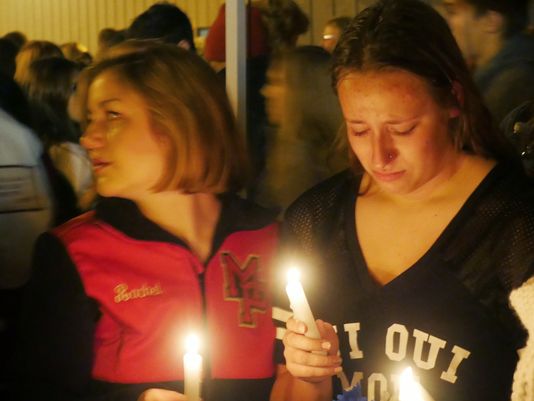
Source: King 5 News
In the aftermath of the shooting at Marysville-Pilchuck High School, the Washington Office of Public Instruction offered information for parents.
Children react to trauma differently than adults. Some may react right away; others may show signs that they are having a difficult time much later. Adults don’t always know when a child needs help coping. The Department of Health and Human Services offers the following tips and information:
Children and youth between 6 and 19 may have some of the same reactions to trauma as younger children. Often younger children want much more attention from parents or caregivers. They may stop doing their school work or chores at home. Some may feel helpless and guilty because they cannot take on adult roles as their family or the community responds to a trauma or disaster.
Children 6–10 years old may fear going to school and stop spending time with friends. They may have trouble paying attention and do poorly in school overall. Some may become aggressive for no clear reason. Or they may act younger than their age by asking to be fed or dressed by their parent or caregiver.
Youth and Adolescents 11–19 years old go through a lot of physical and emotional changes because of their developmental stage. So, it may be even harder for them to cope with trauma. Older teens may deny their reactions to themselves and their caregivers. They may respond with a routine “I’m ok” or even silence when they are upset. Or, they may complain about physical aches or pains because they cannot identify what is really bothering them emotionally. Some may start arguments at home and/or at school, resisting any structure or authority. They also may engage in risky behaviors such as using alcohol or drugs.
How parents, caregivers, and teachers can support children’s recovery
Parents, teachers, and other caregivers can help children express their emotions through conversation, writing, drawing, and singing. Most children want to talk about a trauma, so let them. Accept their feelings and tell them it is ok to feel sad, upset, or stressed. Crying is often a way to relieve stress and grief. Pay attention and be a good listener.
Ask your teen and youth you are caring for what they know about the event. What are they hearing in school or seeing on TV? Try to watch news coverage on TV or the Internet with them. And, limit access so they have time away from reminders about the trauma. Don’t let talking about the trauma take over the family or classroom discussion for long periods of time. Allow them to ask questions.
Adults can help children and youth see the good that can come out of a trauma. Heroic actions, families and friends who help, and support from people in the community are examples. Children may better cope with a trauma or disaster by helping others. They can write caring letters to those who have been hurt or have lost their homes; they can send thank you notes to people who helped. Encourage these kinds of activities.
If human violence or error caused an event, be careful not to blame a cultural, racial, or ethnic group, or persons with psychiatric disabilities. This may be a good opportunity to talk with children about discrimination and diversity. Let children know that they are not to blame when bad things happen.
It’s ok for children and youth to see adults sad or crying, but try not to show intense emotions. Screaming and hitting or kicking furniture or walls can be scary for children. Violence can further frighten children or lead to more trauma.3
Adults can show children and youth how to take care of themselves. If you are in good physical and emotional health, you are more likely to be readily available to support the children you care about. Model self-care, set routines, eat healthy meals, get enough sleep, exercise, and take deep breaths to handle stress.
PRESCHOOL CHILDREN, 0–5 YEARS OLD
Give these very young children a lot of cuddling and verbal support.
– Take a deep breath before holding or picking them up and focus on them, not the trauma.
– Get down to their eye level and speak in a calm, gentle voice using words they can understand.
– Tell them that you still care for them and will continue to take care of them so they feel safe.
EARLY CHILDHOOD TO ADOLESCENCE, 6–19 YEARS OLD
Nurture children and youth in this age group:
– Ask your child or the children in your care what worries them and what might help them cope.
– Offer comfort with gentle words, a hug when appropriate, or just being present with them.
– Spend more time with the children than usual, even for a short while. Returning to school activities and getting back to routines at home is important too.
– Excuse traumatized children from chores for a day or two. After that, make sure they have age-appropriate tasks and can participate in a way that makes them feel useful.
– Support children spending time with friends or having quiet time to write or create art.
– Encourage children to participate in recreational activities so they can move around and play with others.
– Address your own trauma in a healthy way. Avoid hitting, isolating, abandoning, or making fun of children.
– Let children know that you care about them-spend time doing something special; make sure to check on them in a nonintrusive way
Resources
Disaster Distress Helpline
Toll-Free: 1-800-985-5990 Text ‘TalkWithUs’ to 66746
Web Site: http://www.disasterdistress.samhsa.gov
National Suicide Prevention Lifeline
Toll-Free: 1–800–273–TALK (1–800–273–8255);
TTY: 1–800–799–4TTY (1–800–799–4889)
Web Site: http://www.samhsa.gov
National Child Traumatic Stress Network
Web Site: http://www.samhsa.gov/traumaJustice/
